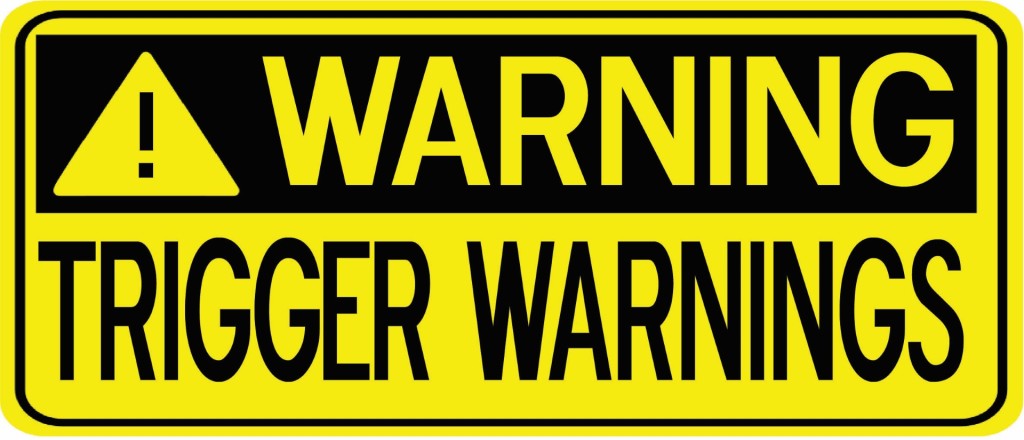
Spoiler Alert: They Aren’t News
With students headed back to university campuses this September (or August, as the case for some of us may be), one of last year’s most fraught topics is returning to relevance for fall 2015: the question of whether or not university professors should be required to include trigger warnings on classroom syllabi.
The debate around the pros and cons of trigger warnings has existed online for years, but did not make it into national media coverage until last year. In 2014, there was a sudden explosion of mainstream editorializing on the topic. As the debate moved from online to the physical space of the classroom, the question became: do students have the right to expect lecturers to inform them of potentially triggering material beforehand, or is this request symptomatic of the decline of free speech on university campuses? Even worse, do they hinder education by coddling students?
Universities are arenas wherein we expect students to become prepared for what ‘the real world’ will throw at them. Through this lens, anything that ‘coddles’ students is most likely negative since it interferes with this preparation. Trigger warnings are perceived to be a capitulation to excessive sensitivity on the part of some students. (According to Jerry Seinfeld, from this perspective trigger warnings seem to be part of a shift in campus culture where students are “too PC” to take a joke.)
This issue is especially pertinent for law students because much of the work we will be involved in is associated with disagreements, unpleasantness, and situations that are offensive to at least someone’s sensibilities. Conflict is our stock and trade: we are preparing ourselves for a career in handling disagreements of varying styles and stakes. If we are not prepared in the classroom now, how can we expect to engage with these issues adequately in our professional lives? More importantly, what does it say about the culture of a law school that censors its classroom discussions, for whatever reason? Censorship, free speech, and the honest exchange of ideas in the classroom are all things that universities must take extremely seriously.
Thankfully, trigger warnings have pretty much nothing to do with the aforementioned concerns and issues. The widespread engrossment over the connection between these concerns and issues to trigger warnings demonstrates a fundamental misunderstanding about what trigger warnings are, and where the impulse to implement trigger warnings is coming from.
Trigger warnings are not red cards that students wave to get out of conversations involving sensitive or offensive topics. Focusing on language like “sensitive” and “offensive” inaccurately shifts the conversation to a student’s feelings, where the immediate response is a simple “toughen up.” Trigger warnings inform students of potentially triggering material that will be covered in lectures and readings, where triggering does not mean offend but does indeed mean trigger, as in triggering Post-Traumatic Stress Disorder. Trigger warnings allow students, the example most commonly cited is students who have survived sexual assault, to prepare for engagement with the topic rather than having the issue sprung on them in a way that may be damaging or harmful.
Often, trigger warnings are as easy as saying, “Read Chapter 5 for next week, and please be aware that some of these cases deal with sexual assault.” Most lecturers already do this because it is simply good pedagogy. These actions do not detract from students’ learning, but enhance it. Additionally, professors are not prevented from dealing with difficult topics, but instead instructors are prompted to engage with their awareness that, yes, certain topics are difficult, and that some of their students will likely have intimate experiences with these difficult subjects. Indeed, the fact that trigger warnings both require and signal this kind of awareness helps us examine where trigger warnings are coming from, and it’s not the desire to simply avoid emotionally difficult material. Trigger warnings allow traumatized students to absent themselves from conversations if they wish, but they also provide an opportunity for instructors to frame conversations in a way that acknowledges the reality of their trauma, which is helpful for everyone who honestly wishes to engage with the material.
Students who need trigger warnings are not refusing to the engage with the material; they have already engaged with it, and in a way that none of us would choose for ourselves if we had the choice. It’s a privilege to be able to say that you do not need a trigger warning.
The question of how to engage with the issue of rape in law school came to the fore in 2014 with Jeannie Suk’s article, “The Trouble With Teaching Rape Law,” and it remains relevant. Suk observed that, “If the topic of sexual assault were to leave the law-school classroom, it would be a tremendous loss—above all to victims of sexual assault.” This is an important truth. But providing trigger warnings reframes the conversation in a way that is respectful of survivors’ experiences. Indeed, in the conversation about rape, rape survivors’ voices should be foregrounded, not removed, and acknowledging the difficulty of that conversation is a crucial step towards having it honestly.
In this sense, trigger warnings are not actually ‘news’ insofar as they represent anything new happening in campus conversations. The phrase itself may be a relatively new one to most of us, but it represents the next stage in our ongoing conversation about power, and who gets to control the narratives that are presented in the classroom. Pretending that students approach difficult subjects untouched by their own experiences leads us to a less honest conversation, and takes us further away from the hard truths of ‘the real world.’
